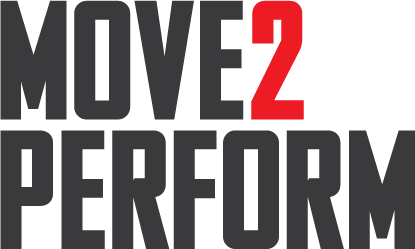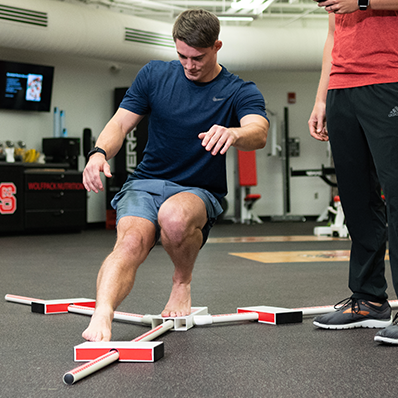Predict Injury Risk with Functional Movement Systems
Written by FMS FMS
Exciting News: Functional Movement Systems approach to injury prevention validated by multiple peer-reviewed research studies.
We’ve long thought that our approach to looking at movement through the lens of function was valuable and contributed to positive outcomes in the world of fitness, performance, and rehabilitation. Intuitively, it makes sense that the better people move, the better they will continue to move. What’s more, over 60,000 professionals around the world have joined the movement and are using our tools to change the lives of those in their care.
Studies have been inconsistent as to whether the FMS composite score can be used as an isolated predictor of injury.
But we know injury risk is multifactorial and to accurately screen for risk, a multiple factor approach should be utilized.
Even in Drs. Kiesel and Plisky's first research publication on the FMS they said "Based on this retrospective analysis, the authors suggest including the FMS™ score in the model by using the individual test scores in addition to the composite score. With this detailed information, it may be possible to specifically identify factors (previous injury, deep squat score, lunge score) that contribute most to injury risk and then focus injury prevention efforts on modifiable factors such as dysfunctional movement."

The solution? Move2Perform is our industry-leading, research-backed system proven to accurately identify and categorize injury risk by weighting multiple risk factors. It allows professionals to:
- Make accurate & objective return to sport or activity decisions.
- Identify pre-season those most likely to suffer from non-contact injury.
And it does so based on what the research says about injury risk.
- Injury risk can be identified
- Injury risk can be categorized
- Injury risk can be modified
Injury Risk Can Be Identified
The first study demonstrating a relationship between injury and Screen score was in 2007.1 There are 5 systematic reviews looking at the Screen total score and injury.4–8 In general, they look at the same studies and come up with conflicting conclusions. One study showed that using just the overall Screen total score was not predictive of injury risk, but evaluating its individual parts was predictive.2 That is, a low score on one test or any pain on any test was predictive of injury. Additionally, one study demonstrated that asymmetries on the Screen relate to injury in NFL players.3 Again, we suggest not using the Screen as a one-off injury prediction tool, because a multifactorial approach is more precise.
The YBT was first shown to have injury predictive value in athletes in 2006.10 Since then, multiple studies have replicated its injury predictive value.11,12,13
The Y Balance Test (YBT) has discriminant validity in those who have had UCL injury, low back pain, and ACL reconstruction.14,15,16
Additionally, two studies have demonstrated the relationship between reduced or asymmetrical dorsiflexion ROM and knee injury.17,18
Beyond athletics, numerous studies use the YBT with the elderly to identify balance deficits, demonstrate the effectiveness of fall reduction interventions, and determine functional recovery after total hip, knee and ankle replacement.19,20,21–23
We analyzed and published data on individual tools such as the Screen and the YBT and demonstrated each tool as an individual risk factor, therefore, they should be included in an injury risk algorithm. The reliability for each portion of the Screen and YBT have been established in numerous studies.5,10,24–31
Injury Risk Can Be Categorized
Injury risk is clearly multifactorial - the more factors you stack on top of each other, the higher the risk for injury. Therefore consideration of multiple risk factors simultaneously is a key component to accurately identifying individuals at greatest risk.
In 2009, we developed the algorithm known as Move2Perform, which weights multiple research-validated risk factors and places each individual in one of 4 risk categories: Optimal, Slight Deficit, Moderate Deficit, and Substantial Deficit.

The M2P categories consider the severity of any single risk factor as well as the presence of multiple risk factors, and in the end, provides a risk category for each individual. This is how FMS applies the multiple risk factor model to an individual.
This M2P approach was first validated by Lehr et al.,32 which was a prospective injury study in college athletes. The study demonstrated that those in the high-risk M2P categories were at a 3.4x increased risk when compared to those in the low-risk categories.
A similar model was used in a large military study in general soldiers and army rangers representative of the general population (Military Power Performance and Prevention Studies (MP3)).33,34 The risk factors identified included pain with movement or clearing tests of the Screen, 3 different components of the YBT Upper and Lower Quarter, and different aspects of a previous injury including severity and self-reported perceived recovery. Additional factors included ankle dorsiflexion mobility asymmetry and reduced aerobic fitness.
We consider these risk factors as gold standard factors for the general population.
The takeaway? MP3 demonstrated that those with more risk factors are at the greatest risk and that this relationship is linear, validating findings from the Lehr study. Thus, the M2P approach for injury risk is what is recommended at FMS for injury prevention.
Injury Risk Can Be Modified
Four studies have shown that the Screen scores do improve with individual exercise programs.35–38 And, when performance on the YBT is improved, injury risk decreases.39,40
When utilizing the M2P approach, as recommended by FMS, a study by Huebner et al.41 has demonstrated that athletes in the moderate risk category can move to the slight category by simply completing a program of corrective exercises as recommended by the FMS corrective exercise strategy/algorithm. A study by Schwartzkoph-Phifer has shown that when athletes with multiple risk factors receive individualized treatment designed to reduce injury risk, they do improve and injury risk is reduced.42
Get Started
Move2Perform software is available in the FMS Pro App (version 1.35.0 or later) to active members who have completed both the FMS Level 1 & Y Balance Test certifications. Purchase the Move2Perform Bundle to obtain both certifications.
References
1. Kiesel, K., Plisky, P. J. & Voight, M. L. Can Serious Injury in Professional Football be Predicted by a Preseason Functional Movement Screen? N. Am. J. Sports Phys. Ther. 2, 147–158 (2007).
2. Mokha, M., Sprague, P. A. & Gatens, D. R. Predicting Musculoskeletal Injury in National Collegiate Athletic Association Division II Athletes From Asymmetries and Individual-Test Versus Composite Functional Movement Screen Scores. J. Athl. Train. 51, 276–282 (2016).
3. Kiesel, K. B., Butler, R. J. & Plisky, P. J. Prediction of injury by limited and asymmetrical fundamental movement patterns in american football players. J. Sport Rehabil. 23, 88–94 (2014).
4. Moran, R. W., Schneiders, A. G., Mason, J. & Sullivan, S. J. Do Functional Movement Screen (FMS) composite scores predict subsequent injury? A systematic review with meta-analysis. Br. J. Sports Med. 51, 1661–1669 (2017).
5. Bonazza, N. A., Smuin, D., Onks, C. A., Silvis, M. L. & Dhawan, A. Reliability, Validity, and Injury Predictive Value of the Functional Movement Screen: A Systematic Review and Meta-analysis. Am. J. Sports Med. 45, 725–732 (2017).
6. Dorrel, B. S., Long, T., Shaffer, S. & Myer, G. D. Evaluation of the Functional Movement Screen as an Injury Prediction Tool Among Active Adult Populations: A Systematic Review and Meta-analysis. Sports Health 7, 532–537 (2015).
7. Almuzara, L. L. Effectiveness of Functional Movement Screen as an injury predictive value in football players. A systematic review. (2018) doi:10.24175/sbd.2018.000051.
8. Fauntroy, V., Fyock, M., Hansen-Honeycutt, J., Nolton, E. & Ambegaonkar, J. P. Using the Selective Functional Movement Assessment for the Evaluation of Dancers’ Functional Limitations and Dysfunctions: A Critically Appraised Topic. J. Sport Rehabil. 1–6 (2019).
9. Bunn, P. dos S., dos Santos Bunn, P., Rodrigues, A. I. & da Silva, E. B. The association between the functional movement screen outcome and the incidence of musculoskeletal injuries: A systematic review with meta-analysis. Physical Therapy in Sport vol. 35 146–158 (2019).
10. Plisky, P. J., Rauh, M. J., Kaminski, T. W. & Underwood, F. B. Star Excursion Balance Test as a predictor of lower extremity injury in high school basketball players. J. Orthop. Sports Phys. Ther. 36, 911–919 (2006).
11. Butler, R. J., Lehr, M. E., Fink, M. L., Kiesel, K. B. & Plisky, P. J. Dynamic balance performance and noncontact lower extremity injury in college football players: an initial study. Sports Health 5, 417–422 (2013).
12. Gonell, A. C., Romero, J. A. P. & Soler, L. M. Relationship between the Y balance test scores and soft tissue injury incidence in a soccer team. Int. J. Sports Phys. Ther. 10, 955 (2015).
13. Smith, C. A., Chimera, N. J. & Warren, M. Association of y balance test reach asymmetry and injury in division I athletes. Med. Sci. Sports Exerc. 47, 136–141 (2015).
14. Garrison, J. C., Arnold, A., Macko, M. J. & Conway, J. E. Baseball players diagnosed with ulnar collateral ligament tears demonstrate decreased balance compared to healthy controls. J. Orthop. Sports Phys. Ther. 43, 752–758 (2013).
15. Garrison, J. C., Bothwell, J. M., Wolf, G., Aryal, S. & Thigpen, C. A. Y BALANCE TESTTM ANTERIOR REACH SYMMETRY AT THREE MONTHS IS RELATED TO SINGLE LEG FUNCTIONAL PERFORMANCE AT TIME OF RETURN TO SPORTS FOLLOWING ANTERIOR CRUCIATE LIGAMENT RECONSTRUCTION. Int. J. Sports Phys. Ther. 10, 602–611 (2015).
16. Mayer, S. W. et al. Functional Testing Differences in Anterior Cruciate Ligament Reconstruction Patients Released Versus Not Released to Return to Sport. Am. J. Sports Med. 43, 1648–1655 (2015).
17. Backman, L. J. & Danielson, P. Low range of ankle dorsiflexion predisposes for patellar tendinopathy in junior elite basketball players: a 1-year prospective study. Am. J. Sports Med. 39, 2626–2633 (2011).
18. Malliaras, P., Cook, J. L. & Kent, P. Reduced ankle dorsiflexion range may increase the risk of patellar tendon injury among volleyball players. J. Sci. Med. Sport 9, 304–309 (2006).
19. Lee, D.-K., Kang, M.-H., Lee, T.-S. & Oh, J.-S. Relationships among the Y balance test, Berg Balance Scale, and lower limb strength in middle-aged and older females. Braz J Phys Ther 19, 227–234 (2015).
20. Abbasi, A., Tabrizi, H., Sarvestani, H. & Rahmanpourmoghaddam, J. Dynamic balance in inactive elder males changes after eight weeks functional and core stabilization training. Middle-East Journal of Scientific Research 11, 304–310 (2012).
21. Wellman, S. S., Klement, M. R. & Queen, R. M. Performance Comparison of Single-Radius Versus Multiple-Curve Femoral Component in Total Knee Arthroplasty: A Prospective, Randomized Study Using the Lower Quarter Y-Balance Test. Orthopedics 40, e1074–e1080 (2017).
22. Gribble, P. A., Hertel, J. & Plisky, P. Using the Star Excursion Balance Test to assess dynamic postural-control deficits and outcomes in lower extremity injury: a literature and systematic review. J. Athl. Train. 47, 339–357 (2012).
23. Powden, C. J., Dodds, T. K. & Gabriel, E. H. THE RELIABILITY OF THE STAR EXCURSION BALANCE TEST AND LOWER QUARTER Y-BALANCE TEST IN HEALTHY ADULTS: A SYSTEMATIC REVIEW. Int. J. Sports Phys. Ther. 14, 683–694 (2019).
24. Minick, K. I. et al. Interrater reliability of the functional movement screen. J. Strength Cond. Res. 24, 479–486 (2010).
25. Teyhen, D. S. et al. The Functional Movement Screen: a reliability study. J. Orthop. Sports Phys. Ther. 42, 530–540 (2012).
26. Shaffer, S. W. et al. Y-balance test: a reliability study involving multiple raters. Mil. Med. 178, 1264–1270 (2013).
27. Plisky, P. J. et al. The reliability of an instrumented device for measuring components of the star excursion balance test. N. Am. J. Sports Phys. Ther. 4, 92–99 (2009).
28. Linek, P., Sikora, D., Wolny, T. & Saulicz, E. Reliability and number of trials of Y Balance Test in adolescent athletes. Musculoskelet Sci Pract 31, 72–75 (2017).
29. Sipe, C. L., Ramey, K. D., Plisky, P. P. & Taylor, J. D. Y-Balance Test: A Valid and Reliable Assessment in Older Adults. J. Aging Phys. Act. 1–7 (2019).
30. Gulgin, H. & Hoogenboom, B. The functional movement screening (fms): an inter-rater reliability study between raters of varied experience. Int. J. Sports Phys. Ther. 9, 14–20 (2014).
31. Gribble, P. A., Brigle, J., Pietrosimone, B. G., Pfile, K. R. & Webster, K. A. Intrarater reliability of the functional movement screen. J. Strength Cond. Res. 27, 978–981 (2013).
32. Lehr, M. E. et al. Field-expedient screening and injury risk algorithm categories as predictors of noncontact lower extremity injury. Scand. J. Med. Sci. Sports 23, (2013).
33. Teyhen, D. S. et al. What Risk Factors Are Associated With Musculoskeletal Injury in US Army Rangers? A Prospective Prognostic Study. Clin. Orthop. Relat. Res. 473, 2948–2958 (2015).
34. Teyhen, D. S. et al. Identification of Risk Factors Prospectively Associated With Musculoskeletal Injury in a Warrior Athlete Population. Sports Health 1941738120902991 (2020).
35. Kiesel, K., Plisky, P. & Butler, R. Functional movement test scores improve following a standardized off-season intervention program in professional football players. Scand. J. Med. Sci. Sports 21, 287–292 (2011).
36. Bodden, J. G., Needham, R. A. & Chockalingam, N. The effect of an intervention program on functional movement screen test scores in mixed martial arts athletes. J. Strength Cond. Res. 29, 219–225 (2015).
37. Campa, F., Spiga, F. & Toselli, S. The Effect of a 20-Week Corrective Exercise Program on Functional Movement Patterns in Youth Elite Male Soccer Players. J. Sport Rehabil. 28, 746–751 (2019).
38. Suzuki, K. et al. Effects of functional movement screen training in high-school baseball players: A randomized controlled clinical trial. Medicine 100, e25423 (2021).
39. Dunsky, A., Barzilay, I. & Fox, O. Effect of a specialized injury prevention program on static balance, dynamic balance and kicking accuracy of young soccer players. World J. Orthop. 8, 317–321 (2017).
40. Schlingermann, B. E., Lodge, C. A., Gissane, C. & Rankin, P. M. The Effects of the GAA15 on Lower Extremity Injury Incidence and Neuromuscular Functional Outcomes in Collegiate Gaelic Games. J. Strength Cond. Res. (2017) doi:10.1519/JSC.0000000000002108.
41. Huebner, B. J., Plisky, P. J., Kiesel, K. B. & Schwartzkopf-Phifer, K. CAN INJURY RISK CATEGORY BE CHANGED IN ATHLETES? AN ANALYSIS OF AN INJURY PREVENTION SYSTEM. Int. J. Sports Phys. Ther. 14, 127–134 (2019).
42. Schwartzkopf-Phifer, K., English, R. A., Mattacola, C. G., Dressler, E. V. & Kiesel, K. B. THE EFFECT of ONE-ON-ONE INTERVENTION in ATHLETES with MULTIPLE RISK FACTORS for INJURY. Int. J. Sports Phys. Ther. 14, 384–402 (2019).
Related Resources
-
Let the YBT Do the Work For You
Posted by Phil Plisky
-
Whiteboard Talks: The Origins of the FMS
Posted by FMS







